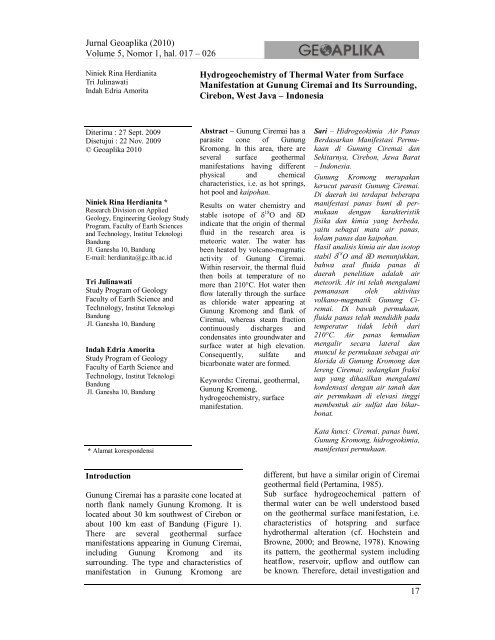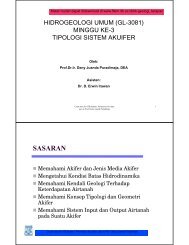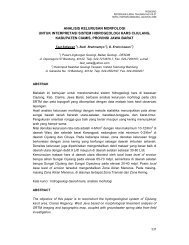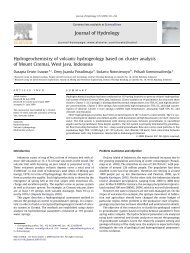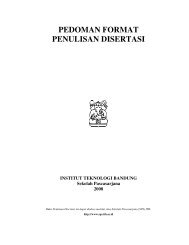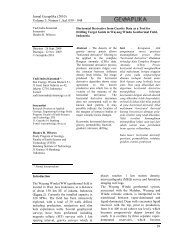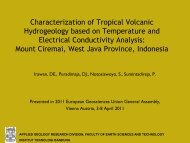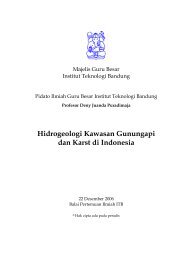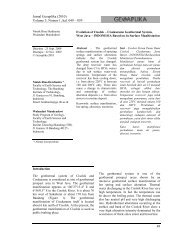Jurnal Geoaplika (2010) Volume 5, Nomor 1, hal. 017 â 026 17 ... - ITB
Jurnal Geoaplika (2010) Volume 5, Nomor 1, hal. 017 â 026 17 ... - ITB
Jurnal Geoaplika (2010) Volume 5, Nomor 1, hal. 017 â 026 17 ... - ITB
- No tags were found...
Create successful ePaper yourself
Turn your PDF publications into a flip-book with our unique Google optimized e-Paper software.
further development of geothermal energy canoptimally be done.This study investigated the Gunung Kromonggeothermal system and its surrounding inWest Java, and was done at the surfacecondition through rock alteration anddischarge of hotspring, steaming ground,kaipohan, fumaroles and mud pool.Furthermore, the condition of geothermalsystem was understood. This study alsoanswered the relationship between theGunung Kromong geothermal system and theactive volcano of Ciremai.Geology and Surface ManifestationGunung Kromong is one of volcanic cone inthe study area. It has morphology with steepslope and elevation of 400 to 450 m. Othercones occur at south of Gunung Kromongincluding Gunung Kuda, Gunung Jajar, andGunung Goong. Alluvial plains cover areaswithin the volcanic cones and mainly are usedas rice paddy and village.Following van Bemmelen (1949), thephysiographic of the study area is included tothe area where is influenced by Quaternaryvolcano of Ciremai. The study area also lies atthe boundary of Bogor Zone. It seems thatsedimentary rocks of Bogor Zone arebasement of Gunung Kromong and its activevolcanoes.Geology of Gunung Kromong and itssurrounding is dominated by Quaternaryvolcanic rocks overlying Tertiary sedimentaryrocks (Djuri, 1973). The basement is a part ofBogor Zone and consists of sandstone ands<strong>hal</strong>e of Cinambo Formation having age ofOligocene, limestone of Kromong Complexhaving age of Miocene, and Plioceneconglomerate and claystone of KaliwanguFormation (Djuri, 1973). Andesitic intrusionsoccur at the study area and form volcaniccones (Djuri, 1973). Geological structures inthe study area are local as a result of Ciremaiactivity. These structures are NE-SW andNW-SE normal faults, young and control theappearance of hotsprings in the study area(Djuri, 1973).Five geothermal surface manifestations wereidentified in this study, i.e. Palimanan,Gunung Kuda, Cipanas, Kedondong andLiang Panas hotsprings. Location and somedirect field measurements are given in Figure1 and Table 1.Surface manifestation of Palimanan is locatedabout 3 km SW the Palimanan residential areaor at a limestone quarry in westside road ofthe cement industry. The manifestation coversarea of about 50 km 2 having several anddischarges different characteristics of thermalfeatures. The temperature of thermal watersranges between 51 and 56°C and pH of about6.4 (Table 1). Water from the hottest springwas taken as sample of KR-1.Thermal water also discharges inside thecement industry site as Palimanan 2 (KR-6).The discharge is a hot pool having area ofabout 4 x 5 m, temperature of 60°C, pH of 6.5and conductivity of +48.0 MeV (Table 1).There are significant smell of H 2 S gas flowsand white travertine deposit around thedischarge area.Other hotsprings occur in Gunung Kuda (KR-2), Cipanas (KR-3), Kedondong (KR-4) andLiang Panas (KR-5). The temperatures ofthermal waters are warm ranging from 36 to38°C and pH of about 6, except water fromCipanas which has pH of 2.6. At Cipanas,kaipohan forms as about 15 x 20 m area withstrong gases diffuse of sulphuric mixed withorganic gases, dead vegetation and strongargillic alteration. The temperature of soil is34.6°C.Chemical CompositionThermal WaterResult of water chemical analyses is given atTable 2. It shows that the thermal waters havetotal dissolved solid (TDS) of 477 to 10330mg/L and electronegativity of 680 to 14800S/cm (Table 2).Based on SiO 2 content, thermal waters in thestudy area can be grouped into two clusters,i.e. thermal water having SiO 2 between 27 and72 mg/L and more than 100 mg/L (Table 2).The first group is represented by KR-1, KR-3and KR-5, whereas the second group is KR-2and KR-4. The different of SiO 2 contents canbe resulted from the difference of thermalfluid type, but also can be due to interaction ofwater with different type of rocks. Theamount of Cl varies up to 3000 mg/L (Table2). The higher the values of TDS andelectronegativity, thermal water will havehigher amount of Cl. The relationship is notshown between the amounts of Cl and SiO 2 or18
SO 4 as shown previous study (e.g. Salvaniaand Nicholson, 1990; Herdianita and Priadi,2008).Thermal waters at the study area commonlyhave ion balance of less than 5%, exceptwaters from Cipanas (KR-3) and Palimanan 6(KR-6, Table 2). The chemical analyses ofKR-3 and KR-6 show the unbalance betweenthe amounts of cation and anion due to eitherthe type of thermal water and its undergoneprocesses or unreliable analyses. Theunbalanced thermal water of KR-3 seems tobe resulted from the first reason, but that ofPalimanan water of KR-6 is due to poorlyanalyses. Therefore the analyses of KR-6 isrejected during interpretation and representedby thermal water of KR-1.Figure 1. Location of geothermal surfacemanifestation in the study area, i.e. around GunungKromong and Gunung Ciremai, West Java19
Tabel 1. Location of water samplings and result on direct field measurementsof temperature, pH and conductivity. Sample KR-7 is a cold water. Sampleswere taken at the end of April 2008.Table 2. Results on chemical and stable isotope analyses of hotsprings in the studyarea, calculations of ion balances, ratios of several elements for the geochemicalinterpretation, and geothermometers* Atomic or molecular ratios** Only for Cl water with Anion-Cation < 5%20
Figure 3. Graphic of the composition of 18 O and D stableisotopes of hotsprings in the study area. The meteoric water line(MWL) is an average of stable isotope composition of meteoricwaters (rain water, groundwater, and surface water) and followsthe equation of Brownlow (1996). SMOW (Standard Mean OceanWater) is stable isotope composition of seawater, i.e. D=0.00 and 18 O=0.00. The magmatic fluid composition follows the stableisotope composition given by White (1974), i.e. +6 to +9‰ 18 Oand -40 to -80‰ D.Figure 4. Relative concentration of Cl - Li - B, inmg/L, of hotsprings in the study area. Samplenumber and location follow Table 1. Sample KR-7 iscold water.22
Relative concentration of Cl, Li and B in Figure 4shows that the thermal waters in the study area,especially KR-1, KR-2 and KR-5, have relativelyhigh Cl compared to the amounts of Li and B.This indicates that the thermal waters areinfluenced by volcano-magmatic activity. Anincrease in molecular ratio of Li/Cl waters fromKR-3 and KR-4 compared to the ratio of KR-1,KR-2 and KR-5 (Figure 4) indicates a moreintensive process of water-rock interaction.However, the low content of B (Table 2) indicatesthat the rock is igneous, not sedimentary rock.Flow of WaterThermal waters from Palimanan (KR-1) andLiang Panas (KR-5) are Cl water directlydischarging from reservoir. As reservoir water, theKR-1 and KR-5 waters also have Na/K ratio ofmore than 15 and high ratio of Na/Ca (Table 2).These all chemical trends are revealed byNicholson (1993).Cipanas water (KR-3) is indirect flow and formsnear the surface, as indicated by low ratios ofNa/K, Cl/Mg and Na/Ca (Nicholson, 1993, Table2). In area like Cipanas, generally reactionbetween thermal water, groundwater andsurrounding rock occurs near the surface.Conduction cooling, then, influences the area.Similarly are thermal waters from Gunung Kuda(KR-2) and Kedondong (KR-4), eventhough thewaters are transition between direct and indirectflow from reservoir. The different Li/B ratio,shown in Figure 4, indicates that the water-rockinteraction in Kedondong have been occurringlonger than in Gunung Kuda.Reservoir and Its TemperatureFigure 4 shows only one variation in B/Cl ratio ofthermal waters in the study area, i.e. less than0.003. This indicates that the reservoir of thermalwaters in the study area is similar. Calculation ofNa-K solute geothermometer using equations ofFournier (1979) and Giggenbach (1988) in Clwaters from Palimanan (KR-1) shows that the subsurface reservoir temperature ranges from 190 and210°C, but slightly cooling to 160 and 180°C atLiang Panas (KR-5, Table 2 and Figure 5).However, reservoir water in the study area mixeswith groundwater and reaches equilibrium nearthe surface at 100 to 120°C as indicated bygeothermometers silica and K-Mg (Table 2 andFigure 5).The reservoir temperature of about 200°C is alsoconfirmed by the occurrence of travertine atPalimanan. The presence of silica residue,kaolinite and alunite in Gunung Kuda, Cipanasand Gunung Jajar indicates that mixing betweenreservoir fluid and groundwater occurs attemperature from 100 to 120°C.Hydrogeochemical of Thermal WaterGeothermal surface manifestations of Ciremaioccur at Gunung Kromong in northern part and atLiang Panas in southern flank of the volcano.Gunung Kromong is a parasite cone of Ciremai; itcaused the hydrogeology of thermal fluid inGunung Kromong is more complicated than thatin the southern flank (Figure 6).As meteoric water recharges to sub surface ofCiremai, the water is heated by volcanicmagmaticactivity of Ciremai. Neither magmaticfluid nor connate water mixes with the heatedmeteoric water. Due to decrease in density ofthermal fluid, the hot water discharges to thesurface. The deep fluid discharges laterally as hotspring in Palimanan (Gunung Kromong, KR-1)and the outflow is due to either geologicalstructure or lithology contact between limestoneand andesite or both. At the southern part ofCiremai, the deep Cl-rich fluid discharges atLiang Panas (KR-5). Here emerging thegroundwater level, rather than structure andlithology controls, seems to be a caused of theoutflow in Liang Panas.The deep fluid also flows upward and fillsreservoir. Furthermore in the reservoir the deepfluid boils at equilibrium temperatures of 190 -210°C, but in the southern part of Ciremai, thereservoir equilibrates at slightly lower temperaturethan in the northern part, i.e. at 160 to 180°C.Boiling causes the thermal fluid to separate intoliquid and vapor phases.The vapor phase or steam is more mobile than theliquid phase. It can reach the peak of Ciremai anddischarges as fumaroles and steaming ground.Pertamina (1985) reported the occurrence ofgeothermal surface manifestation near the craterof Ciremai. The manifestation is dominated bysteaming ground having temperatures of about90°C with very intensive sulfur deposit and CO 2 -rich fumaroles having temperatures of 210°C(Pertamina, 1985).23
Herdianita et al.Figure 5. Relative concentrations of Na - K - Mg of hotsprings inthe study area. The figure shows contour of sub surfacetemperatures calculated by K-Na (t KNa ) and K-Mg (t KMg ,Giggenbach, 1988) geothermometers. Sample number and locationfollow Table 1. Sample KR-7 is cold water.At the southern flank of Gunung Kromong, i.e.area between Gunung Kromong and Ciremai,surface manifestations in Gunung Kuda,Kedondong and Cipanas indicate that steam hascondensed into groundwater and surface waterto form steam condensated SO 4 and HCO 3waters. The condensation is likely to occur attemperature about 100°C. Not onlycondensation, steam also discharges directlythrough permeable zone at Cipanas as kaipohan.Here steam has also mixed with organic gaslikely from claystone unit of KaliwanguFormation.ConclusionGunung Kromong is a parasite cone appearingat the northern part of Ciremai and it is a part ofCiremai geothermal system. However, thesurface manifestations of Gunung Kromongindicate that the hydrogeochemical pattern ofthermal fluid is not as simple as outflow ofCiremai.Geological condition of Gunung Kromong isdominated by andesite and breccias overlyingthe younger sedimentary rocks of limestone andclaystone. Sub surface interaction betweenthermal fluid and sedimentary rock cause themanifestation of Gunung Kromong to becomecomplicated.Five surface manifestations are identified in thisstudy, i.e. hot pools at Palimanan, Gunung Kudaand Kedondong, warm pool at Cipanas andLiang Panas, and kaipohan at Cipanas.Generally, the thermal fluids have temperaturesfrom 36 to 60°C and near neutral pH, exceptwater from Cipanas that has very low pH.Study of hydrogeochemical indicates that thethermal fluids are meteoric origin having beenheated by volcano-magmatic activity ofCiremai. The fluids fill the reservoir and boil attemperature of no more than 210°C. The liquidand vapor phases resulted from boiling causedifferent type of surface manifestations atGunung Kromong and surrounding.24
Figure 6. General model of geothermal system of Gunung Kromong area andsurrounding, sketched as N-S cross section across Gunung Ciremai. Number and type ofthermal waters follow Table 1 and Figure 2 (KR-1=Palimanan, KR-2=Gunung Kuda,KR-3=kaipohan at Cipanas, KR-4=Kedondong and KR-5=Liang Panas). UnscaledReferencesvan Bemmelen, R. W., 1949. TheGeology of Indonesia.Vol.1A. The Hague,Government Printing Office,732p.Brownlow, A. H., 1996.Geochemistry, 2nd Edition.Prentice-Hall, Inc., NewJersey, USA, 580p.Browne, P. R. L., 1978.Hydrothermal alteration inactive geothermal fields.Annual Reviews in EarthPlanet Science, 6: 229-250.Djuri, 1973. Peta GeologiLembar Arjawinangun,Jawa. Geological Researchand Development Centre(GRDC), Indonesia.Fournier, R. O., 1979. A revisedequation for the Na/Kgeothermometer.Geothermal ResourcesCouncil Transactions, 3:221-224.Giggenbach, W.F., 1988.Geothermal solute equilibria.Derivation of Na-Mg-CaGeoindicator. Geochimica etCosmochimica Acta, 52:2749-2765.Herdianita, N. R. and Priadi, B.,2009. Arsenic and mercuryconcentrations at severalgeothermal system in WestJava, Indonesia. <strong>ITB</strong> Journalof Science, 40A, 1: 1-14.Hochstein, M. P. and Browne, P.R. L., 2000. SurfaceManifestation of GeothermalSystems with Volcanic HeatSources. In Encyclopedia ofVolcanoes, H. Sigurdsson,B.F. Houghton, S.R.McNutt, H. Rymer and J.Stix (eds.), Academic Press,835-855.Nicholson, K., 1993. GeothermalFluids. Chemistry andExploration Techniques.Springer-Verlag BerlinHeidelberg, 263p.25
Pertamina, 1985. LaporanSementara SurveiPendahuluan Sisa DaerahJawa. Geothermal Division,Pertamina, Indonesia(Unpublished).Salvania, N.V. and Nicholson,K., 1990. Chemometricsapplied to the fluidchemistry of geothermalfields in the Taupo volcaniczone, New Zealand.Proceeding 12th NZGeothermal Workshop,Auckland University, 157-163.White, D.E., 1974. Diverseorigins of hydrothermal orefluids. Economic Geology,69: 954-973..26


